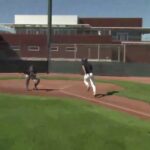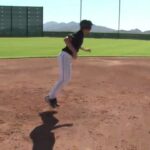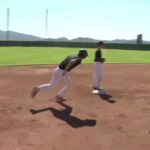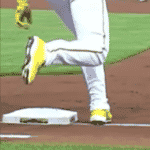NCAA 8-6 When Runners Are Out on Appeals
When Runners Are Out on Appeals
SECTION 6. a. A runner shall be called out on specific appeals that occur as a result of a base running error when:
1) The base runner does not retouch the base before a fielder tags the runner or the base after a fair or foul fly ball is touched in making a legal catch;
2) The runner starts from a position behind the base in order to get a running start, whether on a pitch or tagging up for a fly ball; or
3) The runner fails to touch each base in order when advancing or returning to a base. Either the runner or the missed base may be tagged.
Note 1: No runner may return to touch a missed base after a following runner has scored.
Note 2: When the ball is dead, no runner may return to touch a missed base or the one just left if the runner has advanced to and touched a base beyond the missed base.
Note 3: If the runner is attempting to return to his original base after a fly ball that is caught and the ball is thrown out of play, the runner may retouch and the award is made from his original base.
Note 4: If obstruction causes a runner to miss a base, the runner shall not be called out on appeal for missing the base.
4) The runner does not touch home plate and does not make an attempt to touch it. The fielder may touch either the runner or home plate.
b. The appeals made under this section must take place before the next pitch, play or attempted play or before the pitcher and all infielders have left fair territory on their way to the dugout, if it is an inning-ending or game-ending appeal.
1) The procedure for a base-running appeal play is as follows:
a) A live ball is returned to the base; and
b) If the ball is dead, the pitcher must receive a ball from the umpire and then take a position on the pitcher’s rubber. After the umpire calls “Play,” the pitcher then may legally step back off the rubber and return the ball to the base and the fielder may tag the runner or the base.
2) An appeal is not to be considered as a play or an attempted play.
Exception—If the pitcher balks on an appeal attempt, it is considered a play.
3) The defensive team receives only one chance on an appeal. In the case of multiple appeals, if the defense errs during its first appeal attempt or any base runner advances, the defense loses its right to appeal any runner at any base.
4) If the offensive team initiates a play before the next pitch, the defensive team does not lose its right to appeal.
5) If the defensive team errs on an appeal play and the ball remains in live-ball territory, the appeal will be allowed if:
a) The ball immediately is returned to the base being appealed; and
b) No runners advance on the misplay. If a runner(s) advances, no appeal shall be allowed.
6) If there possibly is more than one runner involved in an appeal at a base, the defensive team must declare on which runner the appeal is being made. If the defensive team fails to identify such runner, the umpire should give no signal. If the appeal is made on the improper runner, the umpire shall give the safe sign and no further appeal shall be allowed at that base.
Note: If, before making the first appeal, the defense announces that it intends to appeal multiple infractions, a throwing error shall cancel only the first appeal if the ball remains in play, or base runners do not advance.
7) If there are two or more appeals during a play, which could make a total of “four outs” in an inning, the defensive team may choose to take any out it desires.
8) If a violation occurs during a play that ends an inning, the appeal must be made before the defensive team leaves the field. When the pitcher and all infielders have left fair territory and the catcher has left his position on their way to their bench, the team is considered to have left the field.
9) If there are two outs before the appeal on a runner, the appeal becoming the third out, no runners following the appealed out shall score, and if the appeal is a force out, no runners preceding or following the appealed out shall score (see Rule 2 – Force Play).
Note: If the defense will make more than one appeal, the defense must appeal in the correct order unless it is an advantageous “fourth out” appeal.
10) It is not a balk for a pitcher, while in contact with the rubber (does not step back), to throw to an unoccupied base for the purpose of making an appeal play.










